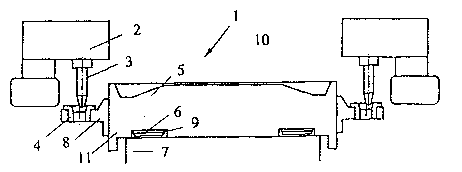Une partie des informations de ce site Web a été fournie par des sources externes. Le gouvernement du Canada n'assume aucune responsabilité concernant la précision, l'actualité ou la fiabilité des informations fournies par les sources externes. Les utilisateurs qui désirent employer cette information devraient consulter directement la source des informations. Le contenu fourni par les sources externes n'est pas assujetti aux exigences sur les langues officielles, la protection des renseignements personnels et l'accessibilité.
L'apparition de différences dans le texte et l'image des Revendications et de l'Abrégé dépend du moment auquel le document est publié. Les textes des Revendications et de l'Abrégé sont affichés :
| (12) Demande de brevet: | (11) CA 2149424 |
|---|---|
| (54) Titre français: | INSTALLATION DE COULEE SEMI-CONTINUE POUR LA FABRICATION DE LINGOTS A LAMINER |
| (54) Titre anglais: | SEMI-CONTINUOUS CASTING EQUIPMENT FOR THE MANUFACTURE OF ROLL INGOTS |
| Statut: | Réputée abandonnée et au-delà du délai pour le rétablissement - en attente de la réponse à l’avis de communication rejetée |
| (51) Classification internationale des brevets (CIB): |
|
|---|---|
| (72) Inventeurs : |
|
| (73) Titulaires : |
|
| (71) Demandeurs : |
|
| (74) Agent: | SMART & BIGGAR LP |
| (74) Co-agent: | |
| (45) Délivré: | |
| (86) Date de dépôt PCT: | 1994-09-12 |
| (87) Mise à la disponibilité du public: | 1995-04-20 |
| Licence disponible: | S.O. |
| Cédé au domaine public: | S.O. |
| (25) Langue des documents déposés: | Anglais |
| Traité de coopération en matière de brevets (PCT): | Oui |
|---|---|
| (86) Numéro de la demande PCT: | PCT/NO1994/000150 |
| (87) Numéro de publication internationale PCT: | NO1994000150 |
| (85) Entrée nationale: | 1995-05-15 |
| (30) Données de priorité de la demande: | ||||||
|---|---|---|---|---|---|---|
|
Installation de coulée semi-continue et directe en coquille pour la fabrication de lingots à laminer. L'installation comporte un réservoir supérieur (10) pour métal, une matrice de coulée ou matrice (2) montée sous le réservoir et dotée d'un orifice d'entrée et d'un orifice de sortie, et un fond (7) mobile verticalement prévu au niveau de l'orifice de sortie et muni d'un sabot de coulée (5) adapté pour venir s'appuper contre l'orifice de sortie au début du cycle de coulée. Le sabot de coulée est monté mobile (en 6) sur le fond (7) et conçu pour être solidaire de celui-ci une fois qu'il se trouve en position centrée par rapport à la matrice de coulée (2). En outre, des dispositifs de centrage correspondants (3, 4, 8) destinés respectivement à la matrice de coulée et au sabot de coulée sont prévus pour centrer le sabot de coulée par rapport à la matrice de coulée.
Direct chill, semi-continuous casting equipment for the manufacture of roll
ingots. The equipment comprises an upper metal reservoir (10), a casting die
or die (2) fitted below the metal reservoir with an inlet and an outlet and a
vertically moveable base (7) fitted at the outlet with a casting shoe (5)
which is designed to bear against the outlet at the start of a casting cycle.
The casting shoe is mounted as a moveable shoe (at 6) on the base (7) and is
designed to be locked in relation to the base when it has been brought into a
centred position in relation to the casting die (2). Furthermore,
corresponding centring devices (3, 4, 8) for the casting die and the casting
shoe respectively are fitted for centring the casting shoe in relation to the
casting die.
Note : Les revendications sont présentées dans la langue officielle dans laquelle elles ont été soumises.
Note : Les descriptions sont présentées dans la langue officielle dans laquelle elles ont été soumises.

2024-08-01 : Dans le cadre de la transition vers les Brevets de nouvelle génération (BNG), la base de données sur les brevets canadiens (BDBC) contient désormais un Historique d'événement plus détaillé, qui reproduit le Journal des événements de notre nouvelle solution interne.
Veuillez noter que les événements débutant par « Inactive : » se réfèrent à des événements qui ne sont plus utilisés dans notre nouvelle solution interne.
Pour une meilleure compréhension de l'état de la demande ou brevet qui figure sur cette page, la rubrique Mise en garde , et les descriptions de Brevet , Historique d'événement , Taxes périodiques et Historique des paiements devraient être consultées.
| Description | Date |
|---|---|
| Le délai pour l'annulation est expiré | 1999-09-13 |
| Demande non rétablie avant l'échéance | 1999-09-13 |
| Réputée abandonnée - omission de répondre à un avis sur les taxes pour le maintien en état | 1998-09-14 |
| Demande publiée (accessible au public) | 1995-04-20 |
| Date d'abandonnement | Raison | Date de rétablissement |
|---|---|---|
| 1998-09-14 |
Le dernier paiement a été reçu le 1997-08-18
Avis : Si le paiement en totalité n'a pas été reçu au plus tard à la date indiquée, une taxe supplémentaire peut être imposée, soit une des taxes suivantes :
Les taxes sur les brevets sont ajustées au 1er janvier de chaque année. Les montants ci-dessus sont les montants actuels s'ils sont reçus au plus tard le 31 décembre de l'année en cours.
Veuillez vous référer à la page web des
taxes sur les brevets
de l'OPIC pour voir tous les montants actuels des taxes.
| Type de taxes | Anniversaire | Échéance | Date payée |
|---|---|---|---|
| TM (demande, 3e anniv.) - générale | 03 | 1997-09-12 | 1997-08-18 |
Les titulaires actuels et antérieures au dossier sont affichés en ordre alphabétique.
| Titulaires actuels au dossier |
|---|
| NORSK HYDRO A.S. |
| Titulaires antérieures au dossier |
|---|
| HARALD JR. NæSS |
| IDAR STEEN |